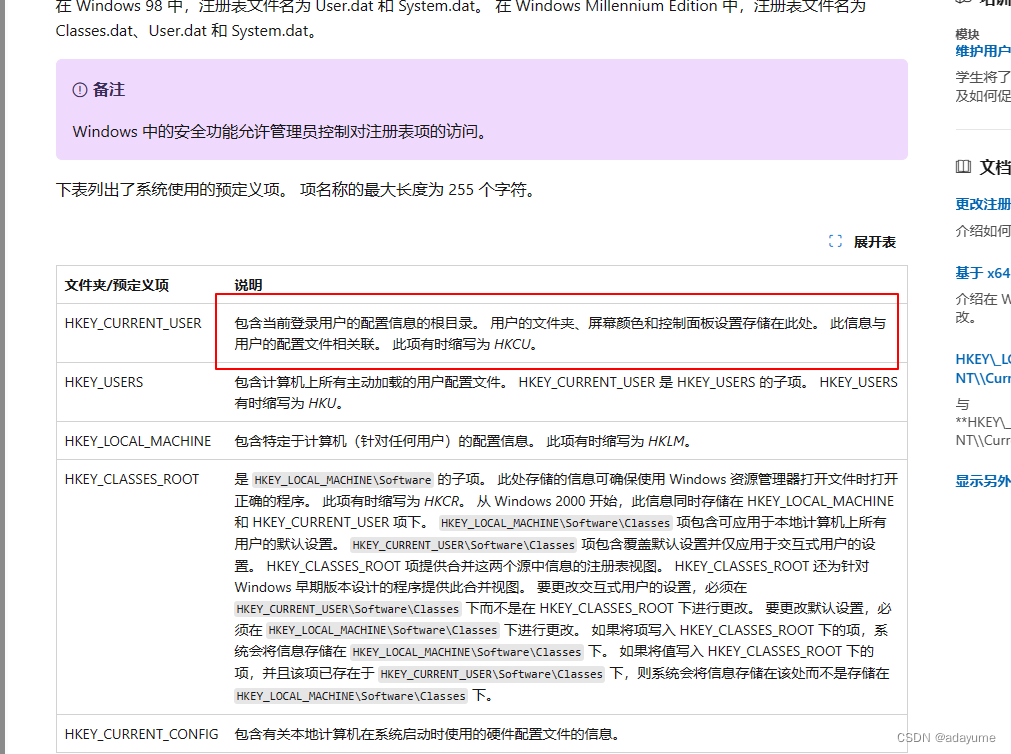处理进程在SYSTEM权限下无法读取HKEY_CURRENT_USER注册表的问题
一、背景
? ? ? ? 最近在工作中碰到了,某个进程在SYSTEM权限下无法读取到HKEY_CURRENT_USER注册表的问题。所以写一下文章记录下排查和处理的过程。
二、排查和处理
????????环境比较奇怪,是WIN7下的USER相关权限的账号才会出现(但最终发现WIN10下也会出现)。
????????于是用VMBOX弄了WIN7的虚拟机进行调试,在进程读取注册表前的代码使用MESSAGEBOX作人为的断点。当进程运行到相关位置时,出现弹窗。然后使用VS的REMOTEDEBUGGER进行远程调试。发现注册表路径没什么问题, 但是的确读取不到相关信息。RegQueryValueEx函数返回错误码ERROR_FILE_NOT_FOUND。
? ? ? ? 这就很奇怪了,明明注册表就存在。怀疑是SYSTEM权限的问题,于是google了下相关关键字。看到stackoverflow的相同问题下有人推荐用LoadUserProfile试试。windows - My C++ application running under SYSTEM is unable to create new values or keys in the HKEY_CURRENT_USER registry how can I make it write these values? - Stack Overflow

? ? ? ? 然后根据信息,推测,HKEY_CURRENT_USER应该跟账号有关。也就是说,当进程在SYSTEM权限下时,读取到的HKEY_CURRENT_USER应该是SYSTEM的,而不是当前账号的。面向高级用户的 Windows 注册表 - Windows Server | Microsoft Learn

????????那么处理方式就变为,如何让SYSTEM权限的进程,读取到当前账号下的HKEY_CURRENT_USER了。在网上找了下,发现了两个处理方法
- 方法一:HKEY_CURRENT_USER实际上是HKEY_USERS\当前登录用户SID,所以获取到账号的SID信息后,与相关的注册表子路径组合起来使用。即HKEY_CURRENT_USER\SOFTWARE\Baidu\BaiduYunGuanjia\installDir转换为HKEY_USERS\SID\SOFTWARE\Baidu\BaiduYunGuanjia\installDir使用
- 方法二:使用LoadUserProfile加载当前用户的Profile后,使用Profile替换HKEY_CURRENT_USER。
????????我是选择了方法二去试试,下面也是方法二示例的代码。方法一理论上是可以的,但我没有去试。
三、最终代码
#include <iostream>
#include <memory>
#include <Windows.h>
#include <WtsApi32.h>
#include <UserEnv.h>
#include <tchar.h>
#pragma comment(lib, "Wtsapi32.lib")
#pragma comment(lib, "Userenv.lib")
int main()
{
HANDLE hToken = NULL;
bool bImpersonated = false;
do
{
if (WTSQueryUserToken(WTSGetActiveConsoleSessionId(), &hToken) == FALSE)
{
std::cerr << "WTSQueryUserToken fail, GetLastError " << GetLastError() << "\n";
break;
}
if (ImpersonateLoggedOnUser(hToken) == FALSE)
{
std::cerr << "ImpersonateLoggedOnUser fail, GetLastError " << GetLastError() << "\n";
break;
}
bImpersonated = true;
DWORD nameLen = MAX_PATH;
TCHAR userName[MAX_PATH + 1] = { 0 };
if (GetUserName(userName, &nameLen) == FALSE)
{
std::cerr << "GetUserName fail, GetLastError " << GetLastError() << "\n";
break;
}
PROFILEINFO profileInfo;
memset(&profileInfo, 0, sizeof(PROFILEINFO));
profileInfo.dwSize = sizeof(PROFILEINFO);
profileInfo.lpUserName = userName;
profileInfo.dwFlags = PI_NOUI;
if (LoadUserProfile(hToken, &profileInfo) == FALSE)
{
std::cerr << "LoadUserProfile fail, GetLastError " << GetLastError() << "\n";
break;
}
// 这里读取注册表
HKEY hKey = NULL;
if (RegOpenKey(reinterpret_cast<HKEY>(profileInfo.hProfile),
_T("SOFTWARE\\Baidu\\BaiduYunGuanjia"),
&hKey) == ERROR_SUCCESS)
{
DWORD dataLen = 0;
LPCTSTR regName = _T("installDir");
if (RegQueryValueEx(hKey, regName, NULL, NULL, NULL, &dataLen) == ERROR_SUCCESS)
{
auto dataBuf = std::make_unique<BYTE[]>(dataLen + 1);
if (RegQueryValueEx(hKey, regName, NULL, NULL, dataBuf.get(), &dataLen) == ERROR_SUCCESS)
{
std::wcout << reinterpret_cast<LPCWSTR>(dataBuf.get()) << L"\n";
}
}
RegCloseKey(hKey);
hKey = NULL;
}
UnloadUserProfile(hToken, profileInfo.hProfile);
} while (false);
if (bImpersonated)
{
RevertToSelf();
bImpersonated = false;
}
if (hToken != NULL)
{
CloseHandle(hToken);
hToken = NULL;
}
return 0;
}四、最终处理方式
? ? ? ? 当然我最终还是没有使用上面的相关代码处理,虽然实测过可以。
????????获取注册表的代码的作用是判断注册表的值是否可以执行后续的代码,那么,将相关的代码移动到提权前处理也行,比上面的处理方式要简单点。所以最后我是移动代码逻辑来处理的。
本文来自互联网用户投稿,该文观点仅代表作者本人,不代表本站立场。本站仅提供信息存储空间服务,不拥有所有权,不承担相关法律责任。 如若内容造成侵权/违法违规/事实不符,请联系我的编程经验分享网邮箱:chenni525@qq.com进行投诉反馈,一经查实,立即删除!
- Python教程
- 深入理解 MySQL 中的 HAVING 关键字和聚合函数
- Qt之QChar编码(1)
- MyBatis入门基础篇
- 用Python脚本实现FFmpeg批量转换
- Hadoop集群配置及测试
- 139 删除链表中的重复元素II
- web前端开发JQuery轮播图,双向兼容手搭挡和自动挡
- python入门-列表与元组(append,pop,len等函数使用),字典,集合使用
- 牛仔行头目标检测竞赛 李沐老师Kaggle(有代码有注释)
- 第6章-第4节-Java中的Date类
- 【华为机试】2023年真题B卷(python)-滑动窗口最大值
- BUG记录 | 使用阿里云OSS实现文件上传后,得到的url无法在浏览器中打开
- 算法通关村——滑动窗口高频问题
- ubuntu22.04 安装gazebo遇到的坑(无法打开显示界面)